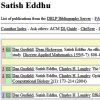  
Dan Gusfield,
Satish Eddhu and
Charles Langley. Optimal, Efficient Reconstruction of Phylogenetic Networks with Constrained Recombination. In JBCB, Vol. 2(1):173-213, 2004.
Keywords: explicit network, from sequences, galled tree, phylogenetic network, phylogeny, recombination, reconstruction.
Note: http://wwwcsif.cs.ucdavis.edu/~gusfield/exfinalrec.pdf.
Toggle abstract
"A phylogenetic network is a generalization of a phylogenetic tree, allowing structural properties that are not tree-like. In a seminal paper, Wang et al.1 studied the problem of constructing a phylogenetic network, allowing recombination between sequences, with the constraint that the resulting cycles must be disjoint. We call such a phylogenetic network a "galled-tree". They gave a polynomial-time algorithm that was intended to determine whether or not a set of sequences could be generated on galled-tree. Unfortunately, the algorithm by Wang et al.1 is incomplete and does not constitute a necessary test for the existence of a galled-tree for the data. In this paper, we completely solve the problem. Moreover, we prove that if there is a galled-tree, then the one produced by our algorithm minimizes the number of recombinations over all phylogenetic networks for the data, even allowing multiple-crossover recombinations. We also prove that when there is a galled-tree for the data, the galled-tree minimizing the number of recombinations is "essentially unique" . We. also note two additional results: first, any set of sequences that can be derived on a galled tree can be derived on a true tree (without recombination cycles), where at most one back mutation per site is allowed; second, the site compatibility problem (which is NP-hard in general) can be solved in polynomial time for any set of sequences that can be derived on a galled tree. Perhaps more important than the specific results about galled-trees, we introduce an approach that can be used to study recombination in general phylogenetic networks. This paper greatly extends the conference version that appears in an earlier work.8 PowerPoint slides of the conference talk can be found at our website. © Imperial College Press."
|